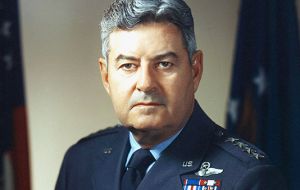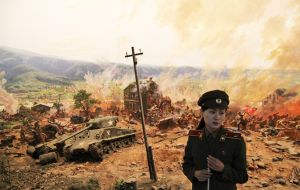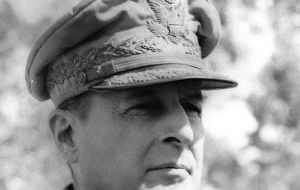MercoPress. South Atlantic News Agency
US already leveled North Korea to ashes during the “forgotten war”
 Air Force general Curtis LeMay, head of the strategic air command during the Korean War, estimated that the American campaign killed 20% of the population.
Air Force general Curtis LeMay, head of the strategic air command during the Korean War, estimated that the American campaign killed 20% of the population.  “We went over there and fought the war and eventually burned down every town in North Korea,” said LeMay.
“We went over there and fought the war and eventually burned down every town in North Korea,” said LeMay.  General MacArthur’s plan was 34 atomic bombs to create “a belt of radioactive cobalt across the neck of Manchuria” to prevent any land invasion from the north
General MacArthur’s plan was 34 atomic bombs to create “a belt of radioactive cobalt across the neck of Manchuria” to prevent any land invasion from the north  North Korean schools have two rooms to study the lives of Kim Il-sung and his son Kim Jong-il: revered grandfather and father of current leader Kim Jong-un
North Korean schools have two rooms to study the lives of Kim Il-sung and his son Kim Jong-il: revered grandfather and father of current leader Kim Jong-un Foreign tourists in North Korea are invariably steered to the Victorious Fatherland Liberation War Museum in Pyongyang, which documents the isolated nation’s crucible years: the 1950-53 war that split the Korean Peninsula in two. In effect there is a detailed explanation of atrocities by the “US aggressors” committed during the war.
Many of these atrocities refer to what Blaine Harden, author and former Washington Post reporter, recently recalled a “long, leisurely and merciless” US bombing campaign: well over half a million tons of bombs dropped, napalm and chemical weapons deployed, cities leveled.
“Although the ferocity of the bombing was recognized as racist and unjustified elsewhere in the world,” says Harden, for many Americans it was just another conflict in a distant and poorly understood country, he concludes. Not for nothing is it called the forgotten war.
The result was perhaps three million dead and, the museum recalls, the first US armistice in history signed without a victory. In three years of fighting a single major city changed hands: Kaesong, which is now the last vestige of a once hopeful détente with the South.
Air Force general Curtis LeMay, head of the strategic air command during the Korean War, estimated that the American campaign killed 20% of the population. “We went over there and fought the war and eventually burned down every town in North Korea,” he said.
General Douglas MacArthur’s plan to win was a list of targets sent to the Pentagon, requesting 34 atomic bombs to create “a belt of radioactive cobalt across the neck of Manchuria so that there could be no land invasion of Korea from the north for at least 60 years”.
Out of the wreckage of that conflict – unresolved to this day – founder Kim Il-sung built his isolated state, squeezed to the north by an old enemy, China, and a new one, the American-backed South. Instead of nursery rhymes, schoolchildren were taught songs about the “American imperialist bastards” and their “lackeys” in Seoul and Tokyo.
Incursions by American spy ships and planes, and huge annual drills by the Americans and South Koreans that still practice invading the North and decapitating its leadership, have worsened the deep official paranoia.
This is the country that US president Donald Trump threatened to wreck in his speech to the United nations General Assembly. “The United Stated has great strength and patience, but if it is forced to defend itself or its allies, we will have no choice but to totally destroy North Korea.”
Not known for his deep reading of history, Trump may be unaware that the United States has in fact destroyed North Korea before. And with “next to no concern for civilian casualties, says Bruce Cumings in his book The Korean War: A History.
This amnesia is helping to fuel the current build up of tensions. A Gallup poll last week found that 58% of Americans would support military action against North Korea if peaceful and diplomatic means fail. Where the Americans have forgotten, however, the North Koreans are trained to remember.
North Korean high schools must set aside two rooms for the study of the lives of Kim Il-sung and his son Kim Jong-il: The Benevolent Sun and the Dear Leader – revered grandfather and father of current leader Kim Jong-un - who defeated the “imperialists”.
Schoolchildren spend a sixth of their day in these rooms, surrounded by portraits and episodes from the struggle against the Americans and Japanese. Anecdotes from Kim Jong-il’s life recall the biblical tales of Jesus Christ as he walked among the people.
All this rarely gets a hearing in America. As Cumings recently noted: “All of our media appear to live in an eternal present, with each new crisis treated as sui generis.” But, he warns, “we forget at our peril” that bellicose threats against the North did not start this week.
“Although the ferocity of the bombing was recognized as racist and unjustified elsewhere in the world,” says Harden, for many Americans it was just another conflict in a distant and poorly understood country, he concludes. Not for nothing is it called the forgotten war.




Top Comments
Disclaimer & comment rules-

Read all commentsThe Korean War began when North Korea invaded South Korea. The United Nations, with the United States as the principal force, came to the aid of South Korea. China came to the aid of North Korea, and the Soviet Union gave some assistance. President Truman later acknowledged that he believed fighting the invasion was essential to the U.S. goal of the global containment of communism .
Sep 26th, 2017 - 12:39 pm 0“Communism was acting in Korea, just as Hitler, Mussolini and the Japanese had ten, fifteen, and twenty years earlier. I felt certain that if South Korea was allowed to fall, Communist leaders would be emboldened to override nations closer to our own shores. If the Communists were permitted to force their way into the Republic of Korea without opposition from the free world, no small nation would have the courage to resist threat and aggression by stronger Communist neighbors”
Commenting for this story is now closed.
If you have a Facebook account, become a fan and comment on our Facebook Page!